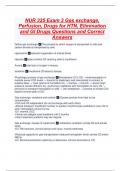NUR 325 Exam 3 Gas exchange,
Perfusion, Drugs for HTN, Elimination
and GI Drugs Questions and Correct
Answers
Define gas exchange ✅The process by which oxygen is transported to cells and
carbon dioxide is transported by cells
Hypoxemia ✅reduced oxygenation of arterial blood
Hypoxia ✅state at which O2 reaching cells is insufficient
Anoxia ✅total lack of oxygen in tissues
Ischemia ✅Insufficient O2 blood to tissues
Physiologic process of gas exchange ✅Atmosphere (21% O2) →chemoreceptors in
medulla sense CO2 levels → transmit to diaphragm and intercostals to contract to
breathe deep → nose (warms & humidifies air) → trachea → bronchi → alveoli (high
pressure causes diffusion to)→pulmonary capillaries with hemoglobin to carry O2 →
perfusion to transport hemoglobin to cells → cell metabolism → process to exhale CO2
begins (reverse path of O2)
Gas exchange: variations and context ✅-Gasses perfuse from high to low
concentration
-CO2 and O2 independent (do not exchange with each other)
-Altered transport: insufficient number or quality of erythrocytes available to carry O2 or
when hemoglobin amount is low
-EX. anemia, SCC
-Infants are obligate nose breathers until 3 months
-Infant respiratory patterns may be irregular
Gas exchange: causes of impairment ✅-Ineffective ventilation (inhale O2 and exhale
CO2)
-EX. Rib fractures, cervical spinal cord injury, muscle weakness
-Reduced capacity for gas transportation (reduced hemoglobin which carries O2 and/or
RBCs)
-EX. Bronchoconstriction (asthma) or obstruction (chronic bronchitis or CF)
,-Inadequate perfusion (hemoglobin to tissues then alveoli)
-EX. Pulmonary edema, acute respiratory distress syndrome, pneumonia
Gas exchange: consequence of impairment ✅-Mild impairment: fatigue, increase HR
and RR (due to compensation)
-More severe impairment: respiratory acidosis (CO2 buildup due to no movement of H+)
-Prolonged or severe: cellular ischemia and necrosis, death
Risk factors for impaired gas exchange ✅-Populations at risk
-Infants: developing, compromised immune systems, fetal hemoglobin for first 5 months
(RBCs do not last as long; reserves very small) which can cause anemia, alveoli and
lung surface area much smaller, narrow branching of peripheral airways that are easily
obstructed
-Older adults: chest muscles weaker, immune system weaker, chest stiffer
-Experience a reduction of erythrocytes, increasing their risk for anemia
-Smoking: damages airways and alveoli, vasoconstriction, bronchoconstriction, damage
to cilia, biggest risk factor to impaired gas exchange
-Risk for aspiration due to altered consciousness
-Being intubated (bypasses protective mechanism for alveoli)
-Prolonged rest: less exercise of chest muscles can cause pneumonia or collapsed lung
-Chronic diseases: increase mucus buildup (COPD), fluid accumulation (HF), etc.
Recognize when an individual has compromised gas exchange ✅-History (problem
based)
-Cough, SOB, chest pain with breathing
-Vital signs: dec in SaO2, inc RR, inc HR, inc temp
-Inspection: clubbing, capillary refill, skin color, lips, 1:2 transverse ratio is normal
(anterior/posterior:lateral), trachea midline, breathe quietly and effortless (not sitting
leaning forward), curvature of vertebrae
-Auscultation: wheezing, stridor, rhonchi, crackles
Gas exchange: optimal vs impaired assessment findings ✅Optimal
-trachea sounds: hars hollow blowing
-bronchiole (1&2 intercostal): high pitched loud hollow blowing
-bronchial vesicular (3&4 intercostal): softer
-vesicular: softest
, Impaired
-wheezing: narrowing of small airways (high pitched whistling)
-stridor: narrowing of trachea and bronchi (emergent)
-rhonchi: sputum or fluid in passages
-crackles: fluid in alveoli
-pleural effusion (hemothorax): no lung sounds
Diagnostic tests for gas exchange (not sure if we have to know these or not) ✅-ABGs,
CBCs (Hgb & Hct), sputum
-Chest x-rays (fluid, object, pneumonia)
-CT (pulmonary embolism)
-Ventilation/perfusion (V/Q) scan (pulmonary emboli)
-PET (pulmonary modules; usually for cancer pt.)
-Skin tests (TB)
-Endoscopy (bronchoscopy, tissue samples, etc.)
Preventions for impaired gas exchange ✅-Primary prevention: infection control,
smoking cessations, immunizations, preventing postoperative complications
-Secondary prevention (screening): flu, pneumonia, TB (Mantoux skin test), COVID
Nursing and collaborative interventions/ interprofessional care for optimizing gas
exchange ✅Smoking cessation, pharmacotherapy, O2 therapy, airway management
and breathing support, chest physiotherapy, nutrition therapy, positioning, invasive
procedures (chest tubes, thoracentesis, bronchoscopy)
-Upper airway drugs: antihistamines (relieve sneezing, rhinorrhea, and nasal itching)
and decongestants (intranasal glucocorticoids have antiinflammatory effect while
sympathomimetics cause vasoconstriction that shrinks edematous membranes)
-Lower airway bronchodilators: glucocorticoids (reduce bronchial hyperreactivity),
sympathomimetics (relieve bronchospasm, stimulate SNS), and anticholinergics (block
PNS so it cannot stimulate constriction of airways)
-Cough suppressants: antitussives act in CNS
-Antimicrobials
-Agents to aid smoking cessation
-Oxygen therapy: nasal cannula (24-44% from 1-6L/min), high flow nasal cannulas
(40L/min), face mask (35-50% from 6-12L/min), partial or non-rebreathing masks (60-
90% from 10-15L/min), venturi masks (24, 28, 31, 35, 40, and 50%)
-COPD patients no greater than 3L
-Chest tubes: remove air or blood from pleura




